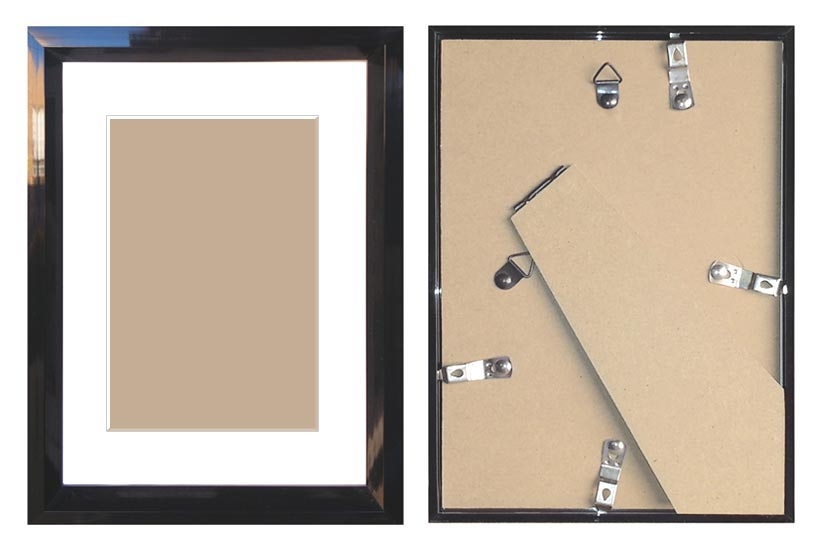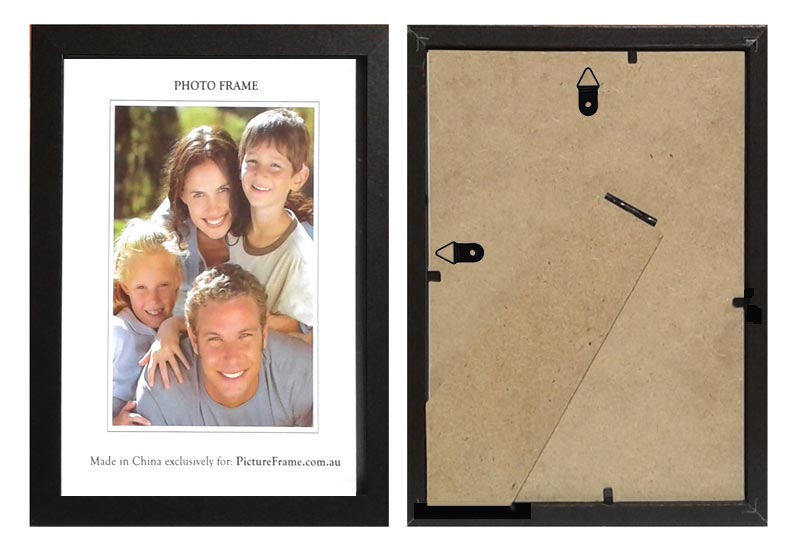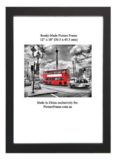To many of our Staff, Customers and people we know, grew up in the 1970’s, 1980s’ or even earlier , the statement "MDF wood frames help  reduce global warming" could seem nonsensical. Back then plastic was fantastic, it was so cheap and convenient, we couldn’t make, buy or use enough of the staff. It was literally and still largely is, ubiquitous, and the picture framing industry was no different from the others. While the custom picture framers never bought much, if any, of the plastic stuff, just about everyone else did. PVC ( plastic ) mouldings were, and still are, a major part of the mass-produced photo frames and picture frames. Just about every picture frames wholesaler, discount chain, department store, chemist chain and discount shop sold and still sells, plastic picture frames. Whether solid or extruded, it was all the same stuff, cheap PVC. This type of plastic was the cheapest material with which make frames, and the mass market never much sought after the best, it always hungered for the cheapest. But, as Bob Dylan sung back in 1964 ” .. the times they are a-changin’ .. “ and they are.
reduce global warming" could seem nonsensical. Back then plastic was fantastic, it was so cheap and convenient, we couldn’t make, buy or use enough of the staff. It was literally and still largely is, ubiquitous, and the picture framing industry was no different from the others. While the custom picture framers never bought much, if any, of the plastic stuff, just about everyone else did. PVC ( plastic ) mouldings were, and still are, a major part of the mass-produced photo frames and picture frames. Just about every picture frames wholesaler, discount chain, department store, chemist chain and discount shop sold and still sells, plastic picture frames. Whether solid or extruded, it was all the same stuff, cheap PVC. This type of plastic was the cheapest material with which make frames, and the mass market never much sought after the best, it always hungered for the cheapest. But, as Bob Dylan sung back in 1964 ” .. the times they are a-changin’ .. “ and they are.
Three score years later, CO2 emissions and the world’s carbon footprint have become major, global issues, whether we trust this statement, believe it, like it, or not. So we have a problem. The world needs to reduce the amount of carbon dioxide, or greenhouse gas, people make, produce and emit, either directly or indirectly. In Australia especially, the recent spate of bushfires, floods and droughts has helped focus the Australian public on this very issue.
A massive contributor to the carbon emissions is the generation of electric power. Generating electric power by burning coal and consuming electricity emit CO2 twice as much of the burning gas or using petrol. So far as the picture framing industry goes, coal-burning power stations generate electricity which is used by extrusion machines to extrude plastic moulding lengths. Below is a table listing some common materials the world industry manufactures with the Megajoules and watt hours required to make each:
| 1 Kilogramme of Material | Megajoules of Energy |
| WOOD (from standing timber) | 3-7MJ (830 to 1,950 watt-hours) |
| MDF ( from recycled timber waste ) | 3.95- 4.32 MJ ( 1,198 watt-hours) |
| STEEL (from recycled steel) | 6-15MJ (1,665 to 4,170 watt-hours). |
| ALUMINIUM (from 100 % recycled aluminium) | 11.35-17MJ (3,150 to 4,750 watt-hours) |
| IRON (from iron ore) | 20-25MJ (5,550 to 6,950 watt-hours) |
| GLASS (from sand, etcetera) | 18-35MJ (5,000 to 9,700 watt-hours) |
| STEEL (from iron) | 20-50MJ (5,550 to 13,900 watt-hours) |
| PAPER (from standing timber) | 25-50MJ (6,950 to 13,900 watt-hours) |
| PLASTICS (from crude oil) | 62-108MJ (17,200 to 31,950 watt-hours) |
| COPPER (from sulphide ore) | 60-125MJ (16,600 to 34,700 watt-hours) |
| ALUMINIUM ( 80% virgin & 20% recycled) | 219 MJ (60,800 watt-hours) |
| SILICON (from silica) | 230-235MJ (63,900 to 65,300 watt-hours) |
| NICKEL (from ore concentrate) | 230-270MJ (63,900 to 75,000 watt-hours) |
| ALUMINIUM (from bauxite) | 227-342MJ (63,000 to 95,000 watt-hours) |
| TITANIUM (from ore concentrate) | 900-940MJ (250,000 to 261,000 watt-hours) |
| ELECTRONIC GRADE SILICON (CVD process) | 7,590-7,755MJ (2,108,700 to 2,154,900 watt-hours). |


Thus, using Australian hard black coal which yields around 25 MJ/kg, to make those PVC plastic frames we would need to burn the equivalent of 29,200 kilograms of coal. On the other hand if we use the same stuff to make MDF frames we would only need to burn the equivalent of 12,848 kilograms of coal.
It is mainly because of the much smaller carbon footprint that we decided some time ago to begin changing all our photo frames, picture frames and poster frames from plastic to reconstituted wood, or MDF. Sustainability in picture framing ( link) has also been another one of our goals and the reduction of CO2 gases and carbon usage goes hand in hand with switching to environmentally better materials. And just as importantly, this demand for a more eco-friendly environment has become a societal chorus.
New statistics say that 85% of all 17 to 33 years old Customers think that businesses should do all they can, or at least more, to alleviate global warming cause by rising CO2 emissions. As an e-Commerce site dealing with hundreds of orders each month we believe that it behoves on us to reduce our products’ carbon liability and help towards climate change. Thus, switching, or adopting, MDF wood frames can help reduce global warming
And as detailed above, one sure way to contribute to this is to change from selling plastic frames to selling wood-MDF Frames. Pedants and purists will correctly point out that MDF has its own problems too such as its formaldehyde component. However, switching to from plastics to wood derivatives is a huge energy saving and is a significant step in the right direction, towards alleviating climate change.
The Environment Pollution Authority (EPA) lists the Australian MDF Environmental Product Declaration (EPD) which states that the residues of wood need to make 1m2 of MDF stores the already sequestered carbon of about 18 kg CO. This is a superlative environmental result when compared to any PVC or plastic materials. Above and beyond the environmental advantages stated priorly , MDF has several other economic, manufacturing and commercial advantages.
The cost is generally comparable if not cheaper than some complex plastics. It can be much stained where as plastics cannot. It is naturally smooth whereas most plastics require expensive, precision extrusion dies to achieve the same surface smoothness.
It has superb machining adaptabilities, unlike most plastics which, generally, are too soft and malleable to withstand these processes. It cuts, drill, sand, chamfers, bores, flutes and grooves quite easily and nicely but plastics cannot so easily subjected to these processes. Unlike plastics, MDF can be laminated with veneers, melamine and other strata. Thank you for reading this post "".








